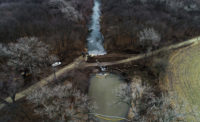Officials of Pacific Gas & Electric Co. are set to appear in U.S. district court in San Francisco on April 9 to plead not guilty to the giant utility’s indictment on 12 criminal charges in the 2010 gas line blast that killed eight and destroyed 38 homes in San Bruno, Calif.
The indictment, which alleges that PG&E knowingly and willfully violated the federal Pipeline Safety Act and its regulations between 2003 and 2010, is the result of a joint federal, state and local investigation, officials said.
According to the April 1 indictment, the San Francisco utility failed to "gather and integrate" data to identify, evaluate and prioritize potential threats to the pipeline, including maintaining proper records and not attending to aging sections in need of repair and replacement.
PG&E also allegedly knew about the potential threats and lack of proper data before the blast occurred, according to the document.
PG&E faces a maximum penalty of $500,000 for each count, or a fine based on gains it realized from the violations or losses to the victims, says the U.S. Justice Dept.
No executives or employees were charged. PG&E provides natural gas and power to about two-thirds of California.
The utility noted its planned plea in an April 2 filing to the federal Securities and Exchange Commission, saying it "believes that criminal charges are not merited and that it did not commit any knowing and willful violations as alleged by the U.S. Attorney.
PG&E “has been doing lots of things to change their operations, but to some degree, with this going to a criminal case, it may be a signal for the broader industry that people are paying attention, and that the industry needs to make sure that San Bruno really was an anomaly as they’ve been saying,” Carl Weimer, executive director of the independent Pipeline Safety Trust, told Platt's Gas Daily, which, like ENR, is a publication of McGraw Hill Financial.
Visible Defect?
National Transportation Safety Board investigators found that the likely cause of the rupture of PG&E’s 30-in.-dia. pipe was a visible defect present along a seam weld at the time of installation in the 1950s.
The defect grew over time until the pipe ruptured during an accidental pressure spike while electrical work was being performed at an upstream compressor station.
No complete record of the pipeline’s origin or of pressure testing has ever been found.
"As alleged in the indictment, PG&E knowingly and willfully failed to identify and evaluate threats to its transmission pipelines, including Line 132 underneath much of San Bruno," said Kamala D. Harris, California attorney general. "When allegedly faced with evidence of transmission line problems, PG&E knowingly and willfully chose not to assess and remediate them."
Melinda Haag, U.S. Attorney for the northern district of California, said, "The citizens of Northern California deserve to have their utility providers put the safety of the community first."
Staying Focused
In an April 1 statement, PG&E CEO Anthony F. Earley said: "San Bruno was a tragic accident. We've taken accountability and are deeply sorry."
Earley took over the role in 2011, the first such appointment from outside the firm, it said then. He had headed Michigan-based DTE Energy.
The firm's corporate parent PG&E Corp. said in a statement that it "pledged to stay focused on building the safest and most reliable natural gas system in the country, despite what it expects will be a lengthy legal process to demonstrate that federal criminal charges filed today have no merit."




Post a comment to this article
Report Abusive Comment